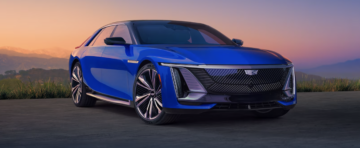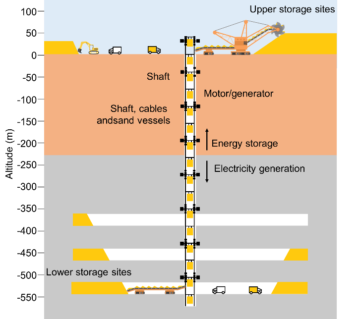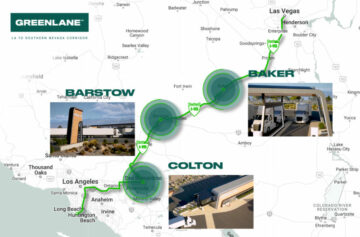Sign up for daily news updates from CleanTechnica on email. Or follow us on Google News!
We write and talk a lot here on CleanTechnica about the electric vehicle revolution, but we often focus on passenger EVs — cars and trucks normal consumers buy. There’s a whole world of heavy-duty and medium-duty commercial electric vehicles that get a bit less attention, but this market is growing. We recently interview Dr. Ray Gallant, Vice President of Sustainability and Productivity Services at Volvo Construction Equipment (Volvo CE), as well as Volvo CE’s Tora Leifland, Head of Public Affairs, and Daniel Black, Product Manager, to further dive into this world in a three-part podcast series. Listen to all three podcasts via the Spotify or SoundCloud embedded players below, and catch a sprinkling of key quotes and takeaways in text form in between.
To start off, Dr. Ray Gallant highlights that electric construction equipment needs to be better than the conventional fossil-fueled alternatives in order to succeed in the industries that use it. “Our job as we see it is to make sure there is no sacrifice in productivity or in efficiency of job sites. In fact, the other way around — if we want this to be successful, we have to be offering benefits that a conventional diesel could not offer.” Naturally, part of that is cutting emissions, but he adds that “we also have to take advantage of the fact that we can offer quieter solutions, we can offer less vibration, we can offer less maintenance costs, we can offer a lower cost of operation. So, all those factors come in to paint a picture now —technology has matured enough now — that we can offer a viable alternative.”
Later in the conversation, they talk more about making these EV options even greener with better battery production, better battery supply chains, longer battery use, and battery recycling. “When it comes to our battery strategy, I think it’s also worth mentioning that we’re investing in battery cell production — so, our own factory, in Mariestad, in Sweden, to get even more control of the sourcing of the batteries,” Leifland states. They are also exploring second-life battery use in order to reduce the need for mining new battery minerals, which both Leifland and Gallant discuss.
Leifland also talking about some jurisdictions requiring use of electric construction equipment. “In the city of Oslo, for example, the city have said all municipal construction should be zero emission by 2025.”
In this second episode with Volvo CE, among many other things, Dr. Gallant talked about the machines they have initially been electrifying at Volvo CE. “As we talked about, different technologies come into play at different size ranges. So, the easiest starting point that we felt for our range of equipment was the compact equipment — and the reason for that is you can use a fairly low-voltage battery pack — a 48V pack — and you can get enough battery size in there without throwing the weight or the volume in your equipment, the envelope, way out of whack. So, it’s fairly easy to do a battery-electric compact piece of equipment. As you move up, we’ve got to go to a higher battery voltage, larger batteries obviously to get the energy we need, but you will eventually get to the point where we need to look at other technologies. So our strategy was to start with battery electric, and then move on to these other technologies.”
They also talk about operating electric construction in off-road work sites, how to implement the equipment pragmatically and in stages, how to maximize their benefits and cut costs, and more.
In this third episode, Dr. Gallant as well as Daniel Black talk more about the charging side of electric construction equipment.
“The challenge that we have is that quite often our job sites are in remote areas. In fact, quite often we’re the ones preparing a site to bring power in, so by definition, power’s not there when you start. We have to be a little more creative. We cannot count on the public infrastructure being available on every one of the sites that we’re going to go to. So we have to be a little more creative in the off-road sector on how we’re going to get power to the machines,” Dr. Gallant says.
“We basically look at three concepts to bring power to the machines. If you happen to be fortunate enough to have grid power available, of course you can connect a charger to grid power and charge your machines from that, so that’s a fairly easy, inexpensive solution. If a grid connection is not readily available at the job site, there is possibility to take portable power to the machines — so that’s the equivalent of a diesel fuel truck going out to the machine and fueling up your machines every day. Instead, you’d have a battery going out to the machine and charging DC battery to DC battery and recharging your machine that way. And finally, if neither one of those options are attractive, you can look at generating your own power on site. Microgeneration systems are now starting to appear that will be viable for certain sites in remote areas where power is just not readily available.”
They also talked about smarter charging on these sites as they and their customers and the tools evolve. Asked about making the best use of charging infrastructure brought out to a job site, Gallant said, “I think that’s where the telematics on both the chargers and the machines come into play, because we can gather that information, we can pull out the energy usage on site, we can adjust the schedules and the charging in real time on site using some of the programs we’re developing specifically for electric machine management on these sites. So, that’s at this point a young, immature tool that you’re starting to see the first versions of that come out, and we’re working with a lot of customers to actually learn the inputs we need and how to do this planning and the logistics around the site charging to make it as efficient as possible for the contractor. And, again, the purpose is to get the energy down as low as possible on the site, the overall energy usage, save costs that way, but also make your assets much more viable in terms of their duty cycles and use.”
There’s much, much more in the podcasts! Listen to them for a deep, deep dive.
Have a tip for CleanTechnica? Want to advertise? Want to suggest a guest for our CleanTech Talk podcast? Contact us here.
Latest CleanTechnica TV Video
[embedded content]
I don’t like paywalls. You don’t like paywalls. Who likes paywalls? Here at CleanTechnica, we implemented a limited paywall for a while, but it always felt wrong — and it was always tough to decide what we should put behind there. In theory, your most exclusive and best content goes behind a paywall. But then fewer people read it!! So, we’ve decided to completely nix paywalls here at CleanTechnica. But…
Thank you!
Advertisement
CleanTechnica uses affiliate links. See our policy here.
- SEO Powered Content & PR Distribution. Get Amplified Today.
- PlatoData.Network Vertical Generative Ai. Empower Yourself. Access Here.
- PlatoAiStream. Web3 Intelligence. Knowledge Amplified. Access Here.
- PlatoESG. Carbon, CleanTech, Energy, Environment, Solar, Waste Management. Access Here.
- PlatoHealth. Biotech and Clinical Trials Intelligence. Access Here.
- Source: https://cleantechnica.com/2024/02/19/electrifying-construction-equipment-volvo-ce-deep-dive/
- :has
- :is
- :not
- :where
- $UP
- 15%
- 2025
- 36
- a
- About
- actually
- Adds
- adjust
- ADvantage
- Advertise
- Affairs
- Affiliate
- again
- All
- also
- alternative
- alternatives
- always
- among
- and
- appear
- ARE
- areas
- around
- AS
- asked
- Assets
- At
- attention
- attractive
- available
- Basically
- batteries
- battery
- battery production
- BE
- because
- been
- behind
- being
- below
- benefits
- BEST
- Better
- between
- Bit
- Black
- both
- bring
- brought
- but
- buy
- by
- CAN
- Can Get
- cannot
- cars
- Catch
- cell
- certain
- chains
- challenge
- charge
- charging
- chip
- City
- cleantech
- Cleantech Talk
- come
- comes
- commercial
- compact
- Companies
- completely
- concepts
- Connect
- connection
- construction
- Consumers
- content
- Contractor
- control
- conventional
- Conversation
- Cost
- Costs
- could
- count
- course
- Creative
- Customers
- Cut
- cut costs
- cutting
- cycles
- Daniel
- day
- dc
- decide
- decided
- deep
- deep dive
- definition
- developing
- diesel
- different
- discuss
- dive
- do
- don
- down
- dr
- easiest
- easy
- efficiency
- efficient
- Electric
- electric vehicle
- electric vehicles
- electrifying
- embedded
- emission
- Emissions
- energy
- enough
- envelope
- episode
- equipment
- Equivalent
- EV
- Even
- eventually
- Every
- every day
- evolve
- evs
- example
- Exclusive
- Exploring
- fact
- factors
- factory
- fairly
- felt
- fewer
- Finally
- First
- Focus
- For
- form
- fortunate
- from
- Fuel
- fueling
- further
- gather
- generating
- get
- Go
- Goes
- going
- got
- greener
- Grid
- Growing
- Guest
- happen
- Have
- he
- head
- heavy-duty
- help
- here
- higher
- highlights
- How
- How To
- HTTPS
- i
- if
- implement
- implemented
- in
- industries
- inexpensive
- information
- Infrastructure
- initially
- inputs
- instead
- Interview
- into
- investing
- IT
- Job
- jurisdictions
- just
- Key
- larger
- LEARN
- less
- like
- likes
- Limited
- links
- listen
- little
- logistics
- longer
- Look
- Lot
- Low
- lower
- machine
- Machines
- maintenance
- make
- Making
- management
- manager
- many
- Market
- max-width
- Maximize
- Media
- mentioning
- minerals
- Mining
- more
- most
- move
- much
- municipal
- naturally
- Need
- needs
- Neither
- New
- news
- no
- normal
- now
- of
- off
- offer
- offering
- often
- on
- ONE
- ones
- operating
- operation
- Options
- or
- order
- Oslo
- Other
- our
- out
- overall
- own
- Pack
- paint
- part
- People
- picture
- piece
- planning
- plato
- Plato Data Intelligence
- PlatoData
- Play
- player
- players
- podcast
- Podcasts
- Point
- policy
- portable
- possibility
- possible
- power
- preparing
- president
- Product
- product manager
- Production
- productivity
- Programs
- public
- publish
- purpose
- put
- quite
- quotes
- range
- ranges
- RAY
- Read
- Reader
- readily
- real
- real-time
- reason
- recently
- recycling
- reduce
- remote
- Revolution
- sacrifice
- Said
- Save
- says
- Second
- sector
- see
- Series
- Services
- should
- side
- site
- Sites
- Size
- smarter
- So
- solution
- Solutions
- some
- Soundcloud
- Sourcing
- specifically
- Spotify
- stages
- start
- Starting
- States
- Stories
- Strategy
- succeed
- successful
- suggest
- supply
- Supply chains
- support
- sure
- Sustainability
- Sweden
- Systems
- T
- Take
- Takeaways
- Talk
- talked
- talking
- team
- Technologies
- telematics
- terms
- text
- than
- that
- The
- their
- Them
- then
- theory
- There.
- These
- they
- things
- Think
- Third
- this
- those
- three
- Throwing
- time
- tip
- to
- tool
- tools
- tough
- truck
- Trucks
- tv
- Updates
- us
- Usage
- use
- uses
- using
- Ve
- vehicle
- Vehicles
- versions
- via
- viable
- vice
- Vice President
- Video
- Voltage
- volume
- volvo
- want
- was
- Way..
- we
- weight
- WELL
- What
- when
- which
- while
- WHO
- whole
- will
- with
- without
- Work
- working
- world
- worth
- write
- Wrong
- you
- young
- Your
- youtube
- zephyrnet
- zero






